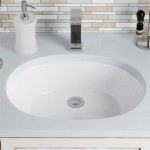Bathroom Sink Counter Size: Guiding Your Renovation Decisions
Selecting the appropriate bathroom sink counter size is a critical decision in bathroom design and renovation. It impacts functionality, aesthetics, and overall space utilization. The right size ensures comfortable use, provides adequate storage and preparation space, and complements the bathroom's overall style. Consideration must be given to the bathroom’s dimensions, the sink type, and the user's needs to achieve an optimal balance. Neglecting this aspect can result in an awkward or inefficient bathroom layout, diminishing both the user experience and the resale value of the property.
The process of determining the ideal bathroom sink counter size involves several stages. Initial measurement of the available space lays the foundation. Subsequentially, evaluation of sink types, from vessel sinks to undermount installations, and their dimensional requirements helps narrow the choices. Understanding standard counter depths and heights is also paramount. Finally, considering factors such as storage needs and the ergonomics of daily use enables the selection of a counter size that harmoniously balances practicality and aesthetic appeal.
Standard Bathroom Sink Counter Dimensions
Understanding standard bathroom sink counter dimensions serves as a useful starting point, providing a baseline for customization. While variations exist, these standard measurements reflect common building codes and ergonomic considerations, offering a foundation upon which more personalized designs can be built. Utilizing these standard dimensions offers a convenient starting point and helps in planning bathroom renovations that comply with common regulatory standards.
The standard depth for a bathroom sink counter typically ranges from 19 to 24 inches. This depth provides sufficient space for comfortable use of the sink and faucet, while also accommodating storage beneath the counter. A shallower depth, such as 19 inches, may be suitable for smaller bathrooms where space is at a premium. Conversely, a deeper counter, up to 24 inches, offers more surface area for toiletries and other bathroom essentials. It is recommended to carefully measure the available space and consider the overall layout to determine the most appropriate depth.
Standard bathroom sink counter height usually falls between 30 and 36 inches. The 30-inch height is a traditional standard that has been common for many years. However, the trend in recent years has shifted towards taller counters, with 36 inches becoming a more prevalent standard. This taller height is considered more ergonomic for many adults, reducing the need to bend over excessively while using the sink. The choice between these heights depends on the users' preferences and physical needs. Families with children may still find the 30-inch height more suitable, while taller individuals may prefer the added comfort of a 36-inch counter. There are also considerations for the ages present within the family. If there are small children or children with disabilities, these will need to be considered.
Counter width is highly variable, dependent on the number of sinks and the overall bathroom size. A single sink typically requires a minimum width of 30 inches. This provides adequate space for the sink itself, as well as some surrounding countertop area. For double sinks, a width of at least 60 inches is generally recommended, allowing enough space for two people to comfortably use the sinks simultaneously. Larger bathrooms may accommodate even wider counters, providing additional space for storage and personal care items. Careful consideration of the bathroom's dimensions and the desired number of sinks is essential when determining the appropriate counter width.
Impact of Sink Type on Counter Size
The type of sink selected significantly impacts the required counter size. Different sink styles have varying dimensional requirements. A vessel sink, for example, sits on top of the counter, effectively increasing the overall height of the sink and the amount of counter space it occupies. An undermount sink, on the other hand, is installed beneath the counter, preserving more of the countertop surface. Understanding these distinctions is crucial for accurately determining the necessary counter dimensions. Moreover, it also allows one to understand how to keep the bathroom from looking too small.
Vessel sinks, characterized by their above-counter installation, demand a lower counter height compared to other sink types. Since the sink itself adds to the overall height, a lower counter height is required to ensure comfortable use. A counter height of 30 to 32 inches is typically appropriate for a vessel sink. The diameter of the vessel sink also influences the required counter depth. Larger vessel sinks necessitate deeper counters to accommodate the sink's footprint and ensure adequate surrounding space. When choosing a vessel sink, the aesthetic appeal must be balanced with the practical considerations of counter height and depth.
Undermount sinks, installed beneath the counter, offer a seamless and streamlined look. Because they are installed beneath the counter, the standard counter height of 34 to 36 inches is generally suitable for undermount sinks. The size of the undermount sink influences the required counter width and depth. Larger undermount sinks require more counter space to accommodate the sink basin. The countertop material must also be capable of supporting the weight of the sink and the water it contains. This type of sink is common but has more involved installation steps.
Drop-in sinks, also known as top-mount sinks, are installed by dropping them into a pre-cut hole in the counter. This installation method is relatively straightforward, making it a popular choice for DIY projects. The rim of the drop-in sink rests on the countertop, providing a finished look. Standard counter heights of 30 to 36 inches are typically suitable for drop-in sinks, depending on the specific sink model. The size and shape of the drop-in sink influence the required counter width and depth. It is essential to carefully measure the sink's dimensions before cutting the hole in the countertop. The amount of space around this sink is also important to consider, especially if this sits within a shared family bathroom.
Optimizing Counter Size for Storage and Ergonomics
Beyond basic dimensions, optimizing the bathroom sink counter size necessitates careful consideration of storage needs and ergonomic principles. A well-designed counter should provide ample space for storing toiletries, towels, and other bathroom essentials, while also ensuring comfortable use for individuals of varying heights and mobility levels. Integrating storage solutions and adhering to ergonomic guidelines enhances both the functionality and user experience of the bathroom.
Incorporating storage into the bathroom sink counter area can significantly enhance its functionality. Drawers and cabinets beneath the counter provide concealed storage for toiletries, cleaning supplies, and other items. Open shelving can be used to display towels and decorative items, adding visual interest to the space. The size and configuration of the storage space should be tailored to the user's specific needs and preferences. Consider the types of items that need to be stored and the frequency with which they are used. Strategic storage solutions can help to declutter the counter area and create a more organized and efficient bathroom environment.
Ergonomics play a crucial role in determining the optimal bathroom sink counter height. As previously noted, the standard counter height of 30 to 36 inches may not be suitable for all individuals. Taller individuals may find a higher counter more comfortable, while shorter individuals may prefer a lower counter. Adjustable-height counters can accommodate users of varying heights, offering flexibility and customization. The placement of the faucet and other fixtures should also be considered from an ergonomic perspective. The faucet should be easily accessible and comfortable to use, without requiring excessive reaching or bending. Proper lighting is also essential, ensuring adequate illumination for tasks such as shaving and applying makeup. The placement of the countertop electrical sockets is also important to consider, if the bathroom user frequently uses electrical appliances.
The shape of the countertop can also influence its functionality and aesthetics. A rectangular countertop is a classic and versatile choice that works well in most bathrooms. A curved or rounded countertop can soften the look of the space and create a more inviting atmosphere. Corner countertops can maximize space utilization in small bathrooms. The choice of countertop shape should be based on the bathroom's dimensions, style, and the user's preferences. Integrating curved edges and waterfall designs adds a touch of elegance and sophistication to these hard surfaces.
Selecting the right bathroom sink counter size is a multi-faceted decision that requires careful consideration of various factors. By understanding standard dimensions, accounting for sink type, and optimizing for storage and ergonomics, it is possible to create a bathroom that is both functional and aesthetically pleasing. Taking the time to plan and measure carefully will ensure a successful bathroom renovation that enhances the user experience for years to come.

What S The Standard Depth Of A Bathroom Vanity

Counter Top Sink Bathroom Vessel Vanity Sizes

American Standard Size Sanitary Ware Bathroom Sink White Wash Basin Solid Surface Washing Vanity China Art Made In Com

What Is The Standard Bathroom Vanity Height Size Guide

51 Cm 20 Inch White Rectangle Shape Grade A Vitreous China Vessel Bathroom Sink Medium Size Counter Top Ceramic Washbasin With Round Corner Made In Com

What Is The Standard Height Of A Bathroom Vanity Sizes Cabinets Vessel Sink
How To Measure A Vanity Sink Bathroom Dimensions Standard Size Vevano

Long Wide Counter Hung Rectangular Basin 550mm X 320mm Perugia

Common Sink Sizes How To Choose The Right Bathroom 2024
How To Measure A Vanity Sink Bathroom Dimensions Standard Size Vevano
Related Posts







